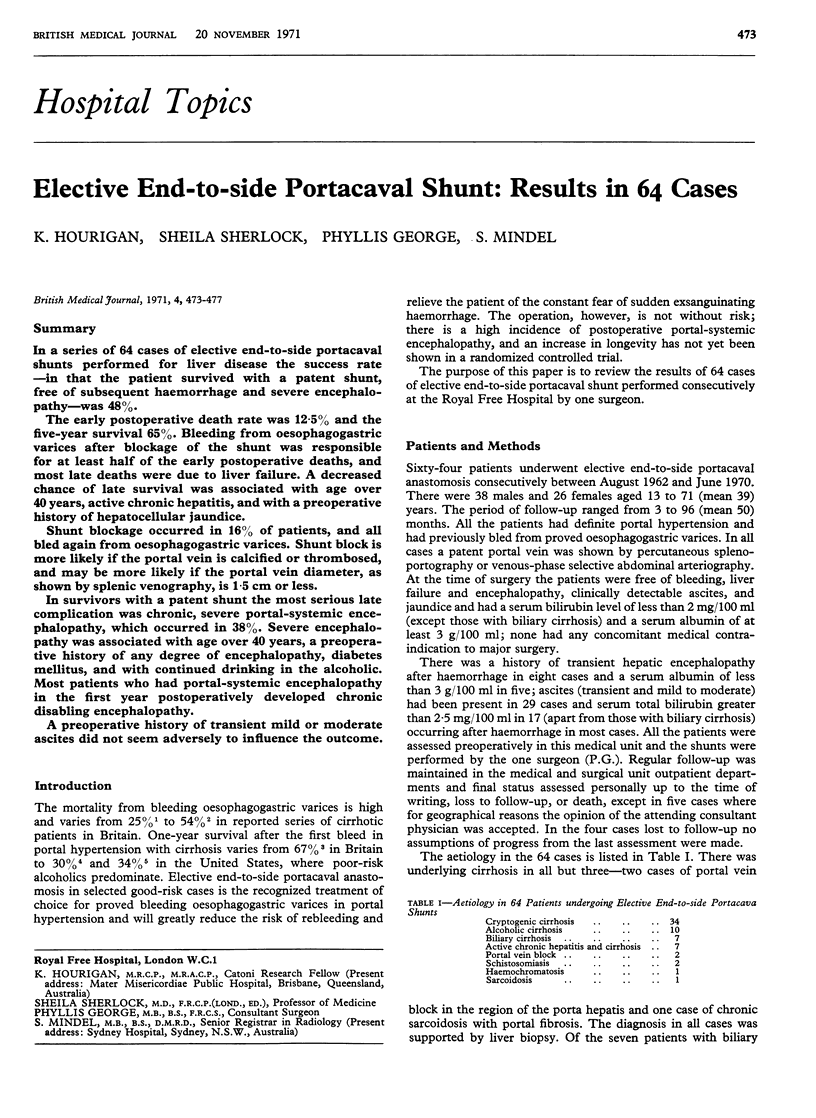Abstract
In a series of 64 cases of elective end-to-side portacaval shunts performed for liver disease the success rate—in that the patient survived with a patent shunt, free of subsequent haemorrhage and severe encephalopathy—was 48%.
The early postoperative death rate was 12·5% and the five-year survival 65%. Bleeding from oesophagogastric varices after blockage of the shunt was responsible for at least half of the early postoperative deaths, and most late deaths were due to liver failure. A decreased chance of late survival was associated with age over 40 years, active chronic hepatitis, and with a preoperative history of hepatocellular jaundice.
Shunt blockage occurred in 16% of patients, and all bled again from oesophagogastric varices. Shunt block is more likely if the portal vein is calcified or thrombosed, and may be more likely if the portal vein diameter, as shown by splenic venography, is 1·5 cm or less.
In survivors with a patent shunt the most serious late complication was chronic, severe portal-systemic encephalopathy, which occurred in 38%. Severe encephalopathy was associated with age over 40 years, a preoperative history of any degree of encephalopathy, diabetes mellitus, and with continued drinking in the alcoholic. Most patients who had portal-systemic encephalopathy in the first year postoperatively developed chronic disabling encephalopathy.
A preoperative history of transient mild or moderate ascites did not seem adversely to influence the outcome.
Full text
PDF




Selected References
These references are in PubMed. This may not be the complete list of references from this article.
- Brown G. J., Milnes Walker R. Portacaval anastomosis. Lancet. 1967 Oct 21;2(7521):854–856. doi: 10.1016/s0140-6736(67)92591-3. [DOI] [PubMed] [Google Scholar]
- GARCEAU A. J., CHALMERS T. C. The natural history of cirrhosis. I. Survival with esophageal varices. N Engl J Med. 1963 Feb 28;268:469–473. doi: 10.1056/NEJM196302282680905. [DOI] [PubMed] [Google Scholar]
- Hislop I. G., Waters T. E., Kellock T. D., Swynnerton B. The natural history of haemorrhage from oesophageal varices. Lancet. 1966 Apr 30;1(7444):945–948. doi: 10.1016/s0140-6736(66)90947-0. [DOI] [PubMed] [Google Scholar]
- Leger L., Lenriot J. P., Dentan T., Lemaigre G. Thromboses des anastomoses porto-caves termino-latérales. J Chir (Paris) 1970 Jan;99(1):5–18. [PubMed] [Google Scholar]
- MCDERMOTT W. V., Jr, PALAZZI H., NARDI G. L., MONDET A. Elective portal systemic shunt. An analysis of 237 cases. N Engl J Med. 1961 Mar 2;264:419–427. doi: 10.1056/NEJM196103022640901. [DOI] [PubMed] [Google Scholar]
- Panke W. F., Rousselot L. M., Burcheli A. R. A sixteen-year experience with end-to-side portacaval shunt for varical hemorrhage: analysis of data and comparison with other types of portasystemic anastomoses. Ann Surg. 1968 Dec;168(6):957–965. doi: 10.1097/00000658-196812000-00003. [DOI] [PMC free article] [PubMed] [Google Scholar]
- READ A. E., LAIDLAW J., SHERLOCK S. Neuropsychiatric complications of portacaval anastomosis. Lancet. 1961 May 6;1(7184):961–963. doi: 10.1016/s0140-6736(61)91880-3. [DOI] [PubMed] [Google Scholar]
- ROUSSELOT L. M., PANKE W. F., BONO R. F., MORENO A. H. Experiences with portacaval anastomosis. Analysis of 104 elective end-to-side shunts for the prevention of recurrent hemorrhage from esophagogastric varices (1952 through 1961). Am J Med. 1963 Mar;34:297–307. doi: 10.1016/0002-9343(63)90116-5. [DOI] [PubMed] [Google Scholar]
- Read A. E., McCarthy C. F., Ajdukiewicz A. B., Brown G. J. Encephalopathy after portacaval anastomosis. Lancet. 1968 Nov 9;2(7576):999–1001. doi: 10.1016/s0140-6736(68)91295-6. [DOI] [PubMed] [Google Scholar]
- Resnick R. H., Chalmers T. C., Ishihara A. M., Garceau A. J., Callow A. D., Schimmel E. M., O'Hara E. T. A controlled study of the prophylactic portacaval shunt. A final report. Ann Intern Med. 1969 Apr;70(4):675–688. doi: 10.7326/0003-4819-70-4-675. [DOI] [PubMed] [Google Scholar]
- Reynolds T. B., Hudson N. M., Mikkelsen W. P., Turrill F. L., Redeker A. G. Clinical comparison of end-to-side and side-to-side portacaval shunt. N Engl J Med. 1966 Mar 31;274(13):706–710. doi: 10.1056/NEJM196603312741303. [DOI] [PubMed] [Google Scholar]
- SHERLOCK S. HAEMATEMESIS IN PORTAL HYPERTENSION. Br J Surg. 1964 Oct;51:746–749. doi: 10.1002/bjs.1800511011. [DOI] [PubMed] [Google Scholar]
- TAYLOR F. W., JONTZ J. G. Cirrhosis with hemorrhage. AMA Arch Surg. 1959 May;78(5):786–790. doi: 10.1001/archsurg.1959.04320050117017. [DOI] [PubMed] [Google Scholar]
- WALKER R. M., SHALDON C., VOWLES K. D. Late results of protacaval anastomosis. Lancet. 1961 Sep 30;2(7205):727–730. doi: 10.1016/s0140-6736(61)90684-5. [DOI] [PubMed] [Google Scholar]
- Zeegen R., Stansfeld A. G., Dawson A. M., Hunt A. H. Prolonged survival after portal decompression of patients with non-cirrhotic intrahepatic portal hypertension. Gut. 1970 Jul;11(7):610–617. doi: 10.1136/gut.11.7.610. [DOI] [PMC free article] [PubMed] [Google Scholar]


